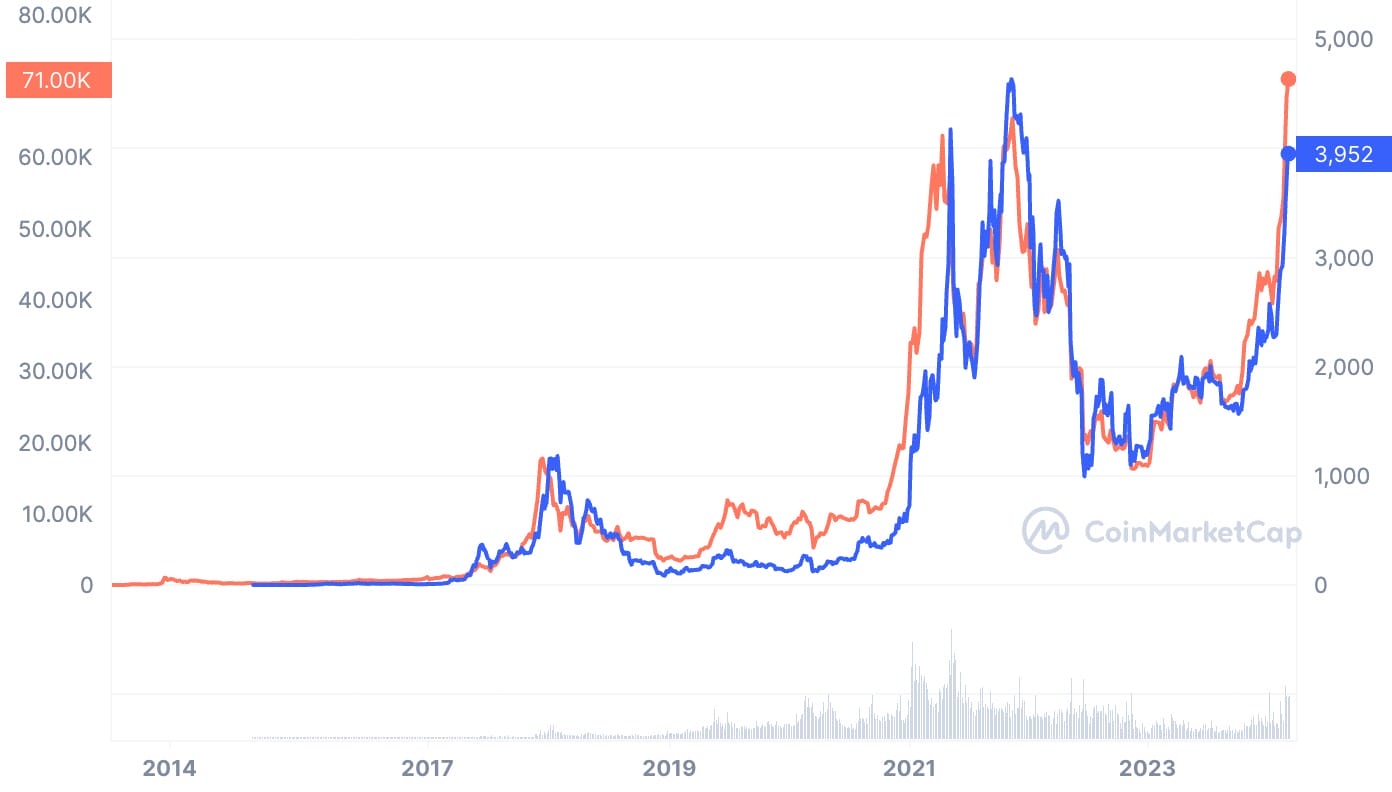Eth And Bitcoin Prediction Insights For The Future
As eth and bitcoin prediction takes center stage, this opening passage beckons readers into a world crafted with good knowledge, ensuring a reading experience that is both absorbing and distinctly original.
Both Ethereum and Bitcoin have revolutionized the world of finance, each offering unique features and applications. While Bitcoin is often seen as digital gold, Ethereum stands out with its smart contract capabilities, making it a powerful platform for decentralized applications. Understanding their histories, current market trends, and technological advancements is crucial for making informed predictions about their futures.
Overview of Ethereum and Bitcoin
Cryptocurrencies have revolutionized the financial landscape, with Bitcoin and Ethereum standing out as two of the most significant players. Their unique features and technological foundations have paved the way for diverse applications in the digital economy. Understanding their history and differences is essential for anyone looking to navigate the crypto world effectively.Bitcoin, introduced in 2009 by an anonymous person or group known as Satoshi Nakamoto, was the first cryptocurrency to successfully use blockchain technology.
It aimed to create a decentralized digital currency that could operate without a central authority. Ethereum, launched in 2015 by Vitalik Buterin and others, expanded on Bitcoin’s concept by introducing smart contracts, enabling developers to create decentralized applications (dApps) on its platform.
Main Differences Between Ethereum and Bitcoin
While both cryptocurrencies share some foundational similarities, they differ significantly in their technology and use cases. Here are the main distinctions:
- Purpose: Bitcoin is primarily a store of value and a medium of exchange, while Ethereum serves as a platform for decentralized applications and smart contracts.
- Technology: Bitcoin uses a simpler scripting language for transactions, whereas Ethereum features a Turing-complete language, which allows for complex computations.
- Transaction Speed: Ethereum typically processes transactions faster than Bitcoin, making it more suitable for certain applications.
- Supply Limit: Bitcoin has a capped supply of 21 million coins, creating scarcity, while Ethereum does not have a fixed supply limit, allowing for continuous issuance.
Current market trends indicate that Bitcoin remains the dominant cryptocurrency by market capitalization, while Ethereum is gaining traction due to its versatility and the growth of decentralized finance (DeFi) applications.
Factors Influencing Price Predictions
Numerous economic factors influence the prices of Ethereum and Bitcoin. Understanding these elements is crucial for making informed investment decisions.
Economic Factors Affecting Prices
Market demand, supply dynamics, and investor sentiment play significant roles in determining the price of cryptocurrencies. For instance, a surge in institutional investment can lead to price increases, while negative news can result in declines.
The Role of Regulations
Regulatory developments can heavily impact cryptocurrency markets. Governments worldwide are increasingly scrutinizing digital assets, and regulations can either bolster investor confidence or create uncertainty, which in turn affects prices.
Technological Advancements
Innovations such as upgrades to blockchain protocols or the introduction of new features can significantly influence price forecasts. For example, Ethereum’s transition to Ethereum 2.0 is expected to enhance scalability and security, potentially driving its price higher.
Prediction Methods for Cryptocurrency
Investors employ various analytical methods to forecast the prices of Ethereum and Bitcoin. Understanding these methodologies can provide valuable insights into market trends.
Analytical Methods

Two primary methods for predicting cryptocurrency prices are fundamental analysis and technical analysis.
- Fundamental Analysis: This approach evaluates economic indicators, market trends, and technological developments to assess a cryptocurrency’s potential value.
- Technical Analysis: This method uses historical price data and trading volume to identify patterns and make predictions about future price movements.
Technical Analysis Tools
Analysts often utilize various tools to aid in technical analysis, including:
- Moving Averages: Used to smooth price data and identify trends.
- Relative Strength Index (RSI): A momentum oscillator that measures the speed and change of price movements.
- Fibonacci Retracement Levels: These are used to identify potential reversal levels in the market.
Fundamental vs. Technical Analysis

Both analytical methods have their pros and cons. Fundamental analysis is grounded in the long-term potential of the cryptocurrencies, while technical analysis focuses on short-term price movements and trends. Investors often use a combination of both to formulate comprehensive strategies.
Historical Price Trends
Examining historical price movements provides context for current market conditions and future predictions.
Price Movements Over the Past Five Years
Bitcoin and Ethereum have experienced significant price fluctuations over the past five years. For instance, Bitcoin reached an all-time high of nearly $64,000 in April 2021, while Ethereum soared to over $4,300 during the same period. Key events that led to significant price changes include:
- The adoption of Bitcoin as legal tender in El Salvador.
- The explosion of DeFi projects on the Ethereum network.
- Market reactions to regulatory news and institutional investments.
Price Correlation Chart
A chart depicting the price correlation between Bitcoin and Ethereum over the last five years would illustrate how these two cryptocurrencies often move in tandem, reflecting overall market sentiment.
Market Sentiment Analysis
Market sentiment is a crucial factor that influences price predictions for both Ethereum and Bitcoin.
Influence of Market Sentiment
Positive or negative sentiment can lead to dramatic price swings. For example, bullish sentiment often arises after significant institutional investments, while bearish sentiment may follow negative press coverage or regulatory crackdowns.
Sentiment Indicators
Investors often rely on various sentiment indicators to gauge market mood, including:
- Fear and Greed Index: Measures market sentiment on a scale from extreme fear to extreme greed.
- Social Media Trends: Monitoring social media platforms can offer insights into public sentiment and potential price movements.
Social Media Impact
Platforms like Twitter and Reddit have become hotspots for crypto discussions. Viral posts or trends can significantly affect market sentiment, leading to rapid price changes for both cryptocurrencies.
Expert Opinions and Forecasts
Insights from industry experts can provide valuable perspectives on the future of Ethereum and Bitcoin.
Notable Expert Predictions
Many analysts offer various forecasts based on market analysis. For instance, some predict Bitcoin could reach $100,000 by 2025, while others are more conservative. Ethereum’s price predictions vary widely, with some experts anticipating it could exceed $10,000 in the same timeframe.
List of Notable Analysts
Here are a few prominent analysts and their price predictions:
- Analyst A: Bitcoin – $100,000 by 2025; Ethereum – $10,000 by 2025.
- Analyst B: Bitcoin – $70,000 by 2025; Ethereum – $8,000 by 2025.
Summary Table of Expert Views
A table summarizing differing expert views could help readers quickly understand the range of predictions for both cryptocurrencies.
Risks and Challenges in Forecasting
Predicting the prices of Ethereum and Bitcoin comes with inherent risks and challenges that investors need to consider.
Key Risks

Volatility is one of the most significant risks associated with cryptocurrencies. Prices can fluctuate dramatically within short periods, influenced by market sentiment, economic factors, and regulatory news.
Challenges for Investors
Investors face challenges such as market manipulation, lack of regulatory clarity, and the rapid pace of technological change. These factors complicate the forecasting landscape and can lead to unexpected outcomes.
Volatility as a Prediction Factor
The cryptocurrency market’s inherent volatility is a critical factor in price predictions. Understanding historical volatility can help investors manage their risk and make informed decisions.
Future Trends and Innovations
Looking forward, several trends and innovations are poised to impact the prices of Ethereum and Bitcoin significantly.
Upcoming Technological Innovations
Developments such as Ethereum’s transition to proof-of-stake and advancements in layer-two solutions aim to enhance scalability, security, and transaction efficiency.
Global Economic Changes
Economic conditions, including inflation rates, interest rates, and geopolitical tensions, can affect investor behavior and influence the prices of cryptocurrencies.
Anticipated Events
A list of anticipated events that may influence future prices includes:
- Regulatory decisions by major economies.
- Major updates or forks in the Ethereum network.
- Increased adoption by financial institutions.
Final Thoughts
In summary, navigating the complex landscape of eth and bitcoin prediction requires an understanding of various factors including market sentiment, expert opinions, and historical trends. As we look ahead, staying informed about technological innovations and potential global economic impacts will be key to anticipating how these cryptocurrencies will evolve.
Essential FAQs
What are the main differences between Ethereum and Bitcoin?
Ethereum enables smart contracts and decentralized applications, while Bitcoin primarily serves as a digital currency.
How do regulations influence cryptocurrency prices?
Regulatory news can significantly affect market sentiment and investor confidence, leading to price volatility.
What tools are commonly used for price prediction?
Technical analysis tools such as moving averages, RSI, and Fibonacci retracements are often utilized for predicting price movements.
How does market sentiment impact price predictions?
Positive or negative sentiment can drive demand, affecting prices significantly, especially in the fast-paced crypto market.
What are the risks involved in predicting cryptocurrency prices?
Market volatility, unexpected regulatory changes, and technological failures pose substantial risks to accurate price predictions.



